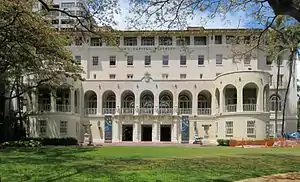Hawaii State Art Museum
The No. 1 Capitol District Building, on the site of the former Armed Services YMCA Building, now houses the Hawaiʻi State Art Museum and the Hawaii State Foundation on Culture and the Arts.

History
While they were both in the cabinet, under King Kamehameha V, American politicians John Mott-Smith and Charles Coffin Harris convinced the legislature to fund a hotel. It first opened in 1872.[1]:173–174 The hotel was converted to a YMCA in 1917 and used by the military in World War I. In 1926 the termite-infested building was finally torn down, and a new one designed in Spanish mission style by Lincoln Rogers of the firm Emory & Webb.[2][3]
The new building was dedicated on March 16, 1928. The two-story U-shaped building includes a swimming pool in its courtyard. It is located at , 250 South Hotel Street, Honolulu, Hawaii. Across Richards Street is the Hawaii State Capitol building. The area was added to the National Register of Historic Places listings in Oahu as the Hawaii Capital Historic District on December 1, 1978.[4]
Museum
The Hawaiʻi State Art Museum is operated by the Hawaii State Foundation on Culture and the Arts, and is located on the second floor of the No. 1 Capitol District Building. Admission is free at all times.
The museum consists of three galleries. In addition to changing temporary exhibitions, there is a permanent display of Hawaiian art. It reflects a mix of Hawaii's ethnic and cultural traditions through 132 works of art by 105 artists. In a wide variety of artistic styles, movements, and media, the exhibition illustrates the varied cultural influences that fuel the creativity of Hawaii's artists.
Predominately comprising works dating from the 1960s to the present, the exhibition depicts the expression of artists throughout the state and their profound contributions toward understanding the people of Hawaii and their aspirations. Sculptor Satoru Abe (born 1926), sculptor Bumpei Akaji (1921-2002), sculptor Sean K. L. Browne (born 1953), sculptor Edward M. Brownlee (born 1929), Mark Chai (born 1954), Jean Charlot (1898-1979), Isami Doi (1883-1931), Juliette May Fraser (1887-1983), Hon Chew Hee (1906-1993), ceramicist Jun Kaneko (born 1942), John Melville Kelly (1877-1962), Sueko Matsueda Kimura (1912-2001), ceramicist Sally Fletcher-Murchison (born 1933), printmaker Huc-Mazelet Luquiens (1881-1961), ceramicist David Kuraoka (born 1946), Ben Norris (1910-2006), Louis Pohl (1915-1999), sculptor Esther Shimazu (born 1957), Shirley Ximena Hopper Russell (1886-1985), Tadashi Sato (1954-2005), Reuben Tam (1916-1991), ceramicist Toshiko Takaezu (1922-2011), Masami Teraoka (born 1936), Madge Tennent (1889-1972), and sculptor Michael Tom (1946-1999) are among the artists whose works are on display.
References
- Ralph Simpson Kuykendall (1953). Hawaiian Kingdom 1854-1874, twenty critical years. 2. University of Hawaii Press. ISBN 978-0-87022-432-4.
- "Hawai'i State Art Museum Brochure" (PDF). Honolulu, HI, USA: Hawai‘i State Foundation on Culture and the Arts. May 18, 2007. p. 2, col. 2. Archived from the original (PDF) on 2011-09-30. Retrieved 17 November 2012.
- Office of Environmental Quality Control (October 2000). "Final Environmental Assessment for No. 1 Capital District Building Honolulu, Oahu, Hawai'i" (PDF). Honolulu, HI, USA: Dept. of Health, State of Hawai‘i. 2.3.1 TECHNICAL CONSIDERATIONS. Archived from the original (PDF) on June 28, 2010. Retrieved November 17, 2012.
- Dale M. Lanzone and Gary Cummins (Spring 1976). "Hawaii Capital Historic District nomination form". National Register of Historic Places. U.S. National Park Service. Retrieved October 20, 2010.